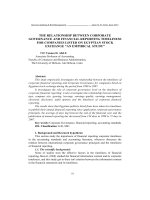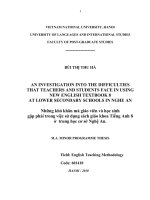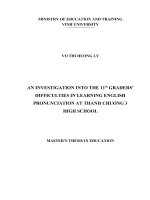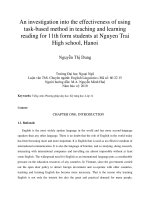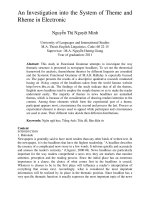An investigation into the relationship between motivations and language learning strategies of first year students at faculty of electrical engineering technology, hanoi university of industry
Bạn đang xem bản rút gọn của tài liệu. Xem và tải ngay bản đầy đủ của tài liệu tại đây (927.67 KB, 77 trang )
VIETNAM NATIONAL UNIVERSITY, HANOI
UNIVERSITY OF LANGUAGES & INTERNATIONAL STUDIES
FACULTY OF POST – GRADUATE STUDIES
*****************
QUÁCH THU HƢƠNG
AN INVESTIGATION INTO THE RELATIONSHIP BETWEEN
MOTIVATIONS AND LANGUAGE LEARNING STRATEGIES OF FIRSTYEAR STUDENTS AT FACULTY OF ELECTRICAL ENGINEERING
TECHNOLOGY, HANOI UNIVERSITY OF INDUSTRY
Nghiên cứu về mối quan hệ giữa động lực học và chiến lƣợc học ngôn ngữ của
sinh viên năm nhất khoa Điện, trƣờng Đại học Công nghiệp Hà Nội
M.A. Minor Programme Thesis
Field: English Teaching Methodology
Code: 60140111
Hanoi - 2017
VIETNAM NATIONAL UNIVERSITY, HANOI
UNIVERSITY OF LANGUAGES & INTERNATIONAL STUDIES
FACULTY OF POST – GRADUATE STUDIES
*****************
QUÁCH THU HƢƠNG
AN INVESTIGATION INTO THE RELATIONSHIP BETWEEN
MOTIVATIONS AND LANGUAGE LEARNING STRATEGIES OF FIRSTYEAR STUDENTS AT FACULTY OF ELECTRICAL ENGINEERING
TECHNOLOGY, HANOI UNIVERSITY OF INDUSTRY
Nghiên cứu về mối quan hệ giữa động lực học và chiến lƣợc học ngôn ngữ của
sinh viên năm nhất khoa Điện, trƣờng Đại học Công nghiệp Hà Nội
M.A. Minor Programme Thesis
Field: English Teaching Methodology
Code: 60140111
Supervisor: Dr. ĐỖ MINH HOÀNG
Hanoi - 2017
DECLARATION
I hereby declare that the thesis entitled “An investigation into the relationship
between motivations and language learning strategies of first-year students at
Faculty of Electrical Engineering Technology, Hanoi University of Industry” is
the result of my own research for the Degree of Master at the University of Languages
and International Studies (ULIS), Viet Nam National University, and this thesis has not
been submitted for any other degrees. I also accept all the requirements of ULIS
relating to the retention and use of M.A Graduation Thesis deposited in the library.
Hanoi, 2017
Quách Thu Hương
i
ACKNOWLEDGEMENTS
First of all, I would like to express my sincere thanks to Dr. Đỗ Minh Hoàng for
helping me complete this study. This paper would not be finished without his support
and guidance. His useful suggestions and valuable critical feedback encouraged me
during the process of conducting this study.
I would also like to give my warmest thanks to the students at Faculty of Electrical
Engineering Technology, Hanoi University of Industry who helped me a lot and
showed their great willingness to take part in my survey and interview.
My special thanks also go to my lecturers, my friends, my classmates for valuable
comments and criticism, their interest and encouragement.
Last but not least, I would like to express my deepest gratitude to my parents and my
brother for their love, care and encouragement.
ii
ABSTRACT
This study investigates into the relationship between motivations and language learning
strategies in the context of learning English as a second language of first-year students
at Faculty of Electrical Engineering Technology, Hanoi University of Industry. The
participants included 100 non-English major freshmen. The data were collected from
survey questionnaires and interviews with 10 students. The results show that the
students had strong instrumental orientations and integrative orientations. It is
suggested that they focused mainly on practical benefits and communicative purposes.
In terms of learning strategy, participants used social and cognitive strategies most
frequently; on the other hand, the use of compensation strategies gained the least
attention. Moreover, there were significant correlations among types of motivation and
learning strategies which were consistent to previous studies. From the findings and
discussion based on data collection, some pedagogical implications, limitations and
recommendations for further studies were included in this research.
iii
TABLE OF CONTENTS
DECLARATION ..............................................................................................................i
ACKNOWLEDGEMENTS .............................................................................................ii
ABSTRACT ................................................................................................................... iii
LIST OF ABBRIVIATIONS ..........................................................................................iv
LISTS OF FIGURES, TABLES AND CHARTS ............................................................ v
PART A: INTRODUCTION ........................................................................................... 1
1. Statement of the problem and rationale of the study ............................................... 1
2. Objectives of the study ............................................................................................. 2
3. Scope of the study .................................................................................................... 2
4. Methods of the study ................................................................................................ 2
5. Significance of the study .......................................................................................... 3
6. Organization of the study ......................................................................................... 3
PART B: DEVELOPMENT ............................................................................................ 5
CHAPTER 1: LITERATURE REVIEW ..................................................................... 5
1.1. The overview of motivation in second language learning ................................ 5
1.2. The overview of language learning strategies................................................... 9
1.3. Related previous studies on the relationship between motivations and
language learning strategies ................................................................................... 11
CHAPTER 2: METHODOLOGY ............................................................................. 14
2.1. The context of the study and the research participants ................................... 14
2.2. Research method ............................................................................................. 15
2.3. Data collection instruments ............................................................................. 15
CHAPTER 3: DATA ANALYSIS AND DISCUSSION .......................................... 25
3.1. Data analysis ................................................................................................... 25
3.2. Discussion ....................................................................................................... 38
PART C: CONCLUSION .............................................................................................. 42
1. Concluding remarks ............................................................................................... 42
2. Pedagogical implications ....................................................................................... 43
3. Limitations and suggestions for further research ................................................... 44
REFERENCES ............................................................................................................... 45
APPENDICES.................................................................................................................. I
Appendix 1: Questionnaire: The language learning questionnaire (English version) . I
Appendix 2: Questionnaire: The language learning questionnaire (Vietnamese
version) ........................................................................................................................ V
Appendix 3: Interview Scripts in English (Summary) ...............................................IX
LIST OF ABBRIVIATIONS
EFT: English as a Foreign Language
I: Interviewer
L2: Second language
LLS: Language Learning Strategies
P: Participant
RQ: Research Question
SILL: Strategy Inventory for Language Learning
iv
LISTS OF FIGURES, TABLES AND CHARTS
Figure 1: Gardner’s Socio-Educational Model of Motivation ............................... 6
Figure 2: Theoretical Framework for L2 Learning Motivation Scale ................... 17
Table 1: Theoretical Framework for L2 Learning Strategy Use Scale .................. 18
Table 2: Scale showing level of (dis)agreement .................................................... 22
Table 3: Oxford’s scale showing the frequencies of strategy use .......................... 23
Table 4: Summary of Descriptive Statistic for Language Learning Motivation ... 25
Chart 1: The overall mean of six motivational types ............................................. 26
Table 5: Descriptive Statistic for Each Motivational Item .................................... 27
Table 6: Summary of Descriptive Statistic for Language Learning Strategy Use30
Chart 2: The overall mean for six types of language strategy use ......................... 31
Table 7: Descriptive Statistic for Each Language Strategy Use Item .................... 32
Table 8: Correlations of motivational and strategy use components ..................... 35
Table 9: Correlation Coefficients between overall motivation and learning ........
strategies ................................................................................................................. 37
v
PART A: INTRODUCTION
In this part, the researcher will present the rationale of the study, the objectives, the
scope, the methods, the significance, and the organization of the study.
1. Statement of the problem and rationale of the study
With educational innovation in recent years, it seems that research trend in English
Language Teaching is shifted from language teaching methodology to language
learning. When teacher centeredness has been substituted by learner centeredness,
teaching method does not play the most important role in leading to success or failure
of teaching and learning second language any more. Besides, other factors such as
learners’ autonomy, learning strategies, learners’ beliefs and attitudes may have
decisive effects on second language acquisition. According to Ellis (1985), language
learning strategies and motivation are considered to be two key components to make
differences in individual language learners. In other words, learners’ motivation and
learning strategies are crucial elements involved in achievement of second language
learning. Hence, it is necessary for both teachers and learners to find out factors which
motivate students to learn English and general strategies used in learning process.
It is the fact that a close relationship between motivations and language learning
strategies has been proved in some research (Ellis, 1994; Wen, 2004). However, it is
hard to find the research which directly shows how much motivations have great
influence on learners’ strategies and what aspects clearly reflect the relationship
between them. That is the reason why more studies should be conducted to investigate
students’ motivations and their learning strategies to learn English in other countries in
general as well as in Vietnam in particular.
From the fact presented above, the researcher can assert that finding “the relationship
between motivations and language learning strategies” is very necessary for students to
develop their English. It is the reason that motivated the researcher to conduct a study
1
on “the relationship between motivations and language learning strategies in the
context of learning English as a second language of first-year students at Faculty of
Electrical Engineering Technology, Hanoi University of Industry”.
2. Objectives of the study
The purposes of the study are to explore types of students’ motivational orientations as
well as learning strategy uses and to examine whether there are any significant links
between language learning motivations and the choice of language learning strategies.
Moreover, the research aims to identify how motivations are related to learning
strategies of first-year students at Faculty of Electrical Engineering Technology, Hanoi
University of Industry. Therefore, three research questions are raised as follows:
What are language learning motivations of first-year students at Faculty of
Electrical Engineering Technology, Hanoi University of Industry?
What are language learning strategies of first-year students at Faculty of
Electrical Engineering Technology, Hanoi University of Industry?
To what extent is motivation correlated with strategy use for learning English of
first-year students at Faculty of Electrical Engineering Technology, Hanoi
University of Industry?
3. Scope of the study
Within the limit of personal ability and reference materials, the study focuses on the
relationship between motivations and language learning strategies in the context of
learning English as a second language of freshmen at Faculty of Electrical Engineering
Technology, Hanoi University of Industry.
4. Methods of the study
The survey research was selected to investigate the relationship between language
learning strategies and motivation. The research instruments were questionnaires and
2
interviews. The participants were 100 first-year students at Faculty of Electrical
Engineering Technology, Hanoi University of Industry who come from four classes.
Data collection was conducted at regular English classes during the first semester of
academic school year 2016 – 2017.
5. Significance of the study
The study presents a broad quantitative sketch of motivational orientations and learning
strategy preferences of first-year students at Faculty of Electrical Engineering
Technology, Hanoi University of Industry. By analyzing these variables and links
between them, the research provides teachers an overall view of students’
developmental trends in language learning styles to choose and apply teaching
techniques more effectively in order to assist their students achieve better results in
learning. From perspectives of learners, furthermore, findings revealed may help
learners hold positive attitudes toward learning English as well as make suitable shortterm and long-term goals to quickly reach their aims.
6. Organization of the study
The study consists of three main parts:
Part I: Introduction, presents the rationale of the study, the objectives, the scope, the
method, the significance and the organization of the study.
Part II: Development, includes three chapters:
Chapter 1: Literature Review, reviews the theories on motivation, second language
learning strategies and related previous studies on relationship between motivation and
learning strategies
Chapter 2: Methodology, describes the setting of the study, the participants and the
research method. Moreover, this chapter shows how the researcher applied the data
collection instruments and the procedure of conducting the study.
3
Chapter 3: Data analysis and discussion, analyzes the figure and information collected,
followed by discussion of findings.
Part III: Conclusion, gives concluding remarks, pedagogical implications, its
limitations and suggestions for further studies.
4
PART B: DEVELOPMENT
CHAPTER 1: LITERATURE REVIEW
This chapter is divided into three major sections. The first section sheds some light on
theoretical background to motivation in second language learning. The second section
shows an overview of language learning strategies. The third section focuses on related
previous studies on relationships between motivation and language learning strategies.
1.1. The overview of motivation in second language learning
1.1.1. Definition of motivation in second language learning
There are many different ways to define motivation. Bandura (1986) defines
motivation as a goal-directed behaviour begun and reinforced by expectations
concerning the anticipated results or effects of actions and effectiveness for performing
those actions. Myron (2004: 10) shared the same opinion that “motivation is the
internal processes that give behaviour its energy and direction including goals, beliefs,
perceptions and expectations”
According to Pintrich (2003), the key construct “motivation” comes from the Latin
verb “movere”, which means to “move”. In terms of second language learning,
Dörnyei (2005, p.65) explains that motivation is a “dynamic, ever-changing process”
which provides “the primary impetus to initiate L2 learning and later the driving force
to sustain the long and often tedious learning process”.
Although these opinions are not exactly the same, they all show that motivation refers
to the strong and powerful reason which involves demanding effort, arousing desire
and raising expectations to promote learning process.
5
1.1.2. Related studies on motivation in second language learning
The history of research on motivation in second language learning was divided into
three main periods by Dörnyei (2005): the social psychological stage (1959–1990), the
cognitive-situated phase (during the 1990s), and the process-oriented period (since
2000).
In the first period, Gardner (1985) introduces his social psychological model which
distinguishes between two motivational orientations: instrumental versus integrative
motivation. Instrumental motivation relates to a desire to learn a second language for
practical reasons such as passing an exam, getting a better job or travelling abroad.
Integrative motivation reflects a desire to learn a second language to interact and
identify with the target language community. In the socio-educational model,
integrativeness and attitudes toward the learning situation (Gardner, 1985; Masgoret
and Gardner, 2003) are considered two main variables which had an influence on
learner motivation. Integrativeness is assessed by attitudes toward the target language
group, interest in foreign languages, and integrative orientation. Attitudes toward the
learning situation are measured by attitudes toward both the language course and the
language teacher.
6
During the cognitive-situated period, various models were made to define motivation
in terms of different components. For example, the well-recognized expectancy-value
model was developed by Eccles, Wigfield, and their colleagues (Wigfield & Eccles,
2000; Wigfield, Eccles, & Rodriguez, 1998). This model considers expectations of
success and subjective task value to be direct determinants of achievement-related
choices. One of the dominant language learning motivation studies is the selfdetermination theory which was designed by Deci and Ryan (1985). In this theory,
motivation is classified into two main categories: intrinsic and extrinsic motivation.
Extrinsic motivation refers to a desire to get a reward and avoid punishment. It
emphasizes “external need to persuade the learner to take part in learning activity such
as homework, grade, or doing something to please teachers” (Arnold, 2000, p.
14). Intrinsic motivation refers to “learning itself having its own reward” (Arnold,
2000, p. 14). It means that the need comes from inside; therefore, the learners are
willingly try to learn what they think it is worth or important for them without rewards.
Crookes and Schmidt (1991) broadens Gardner’s model by including four motivation
constituents: interest, relevance, expectancy, and reward or punishment.
According to a process-oriented model proposed by Dörnyei (2005), the motivational
process can be separated into three phases: pre-actional stage (choice motivation),
action
stage
(executive
motivation),
and
post-actional
stage
(motivational
retrospection). Considerably, Schmidt and Watanabe (2001) identify thirteen
motivational factors. The definitions of the thirteen major categories of motivation in
this study are as follows (Schmidt and Watanabe, 2001, p.316-317):
Intrinsic motivation, statements expressing enjoyment of language learning.
Instrumental orientation, statements concerning the financial, social, or other
benefits of learning a language.
7
Integrative orientation, statements about being able to interact with members of
another cultural group.
Heritage language orientation, statements concerning the students’ attachment to the
language as part of their own identity and cultural heritage.
Interest in foreign languages and cultures, in general (not a specific language).
Task value, that is, the value of the language course.
Expectancy, statements concerning a student’s belief that s/he will do well and
receive a good grade in the course.
Anxiety, statements concerning test and speaking anxiety.
Language aptitude, the student’s own perception of her/his aptitude for
grammar, pronunciation.
Competitiveness, statements about doing better than other students and getting good
grades.
Cooperativeness, statements concerning relationships with other students and the
teacher and learning in a cooperative environment
Motivational strength, statements concerning one’s intention to put one’s best effort
into learning the language, keep up with the course, etc.
In short, it is obvious that no model can cover exactly all the features of language
learning motivation. However, what the mentioned- above authors offer is to aim at
finding out the nature of motivation and types of motivation in L2 learning.
Significantly, four types of motivation are frequently used in studies on L2 acquisition,
namely instrumental motivation, integrative motivation, intrinsic motivation and
extrinsic motivation. Furthermore, the motivational scale developed by Schmidt and
Watanabe (2001) with thirteen motivational factors is also considered a popular
instrument to measure motivation in language learning.
8
1.2. The overview of language learning strategies
1.2.1. Definition of learning strategies
Chamot (1987, p.71) gives a definition of language learning strategies as “techniques,
approaches or deliberate actions that students take in order to facilitate the learning and
recall of both linguistic and content area information”. She proposes that some
language learning strategies are observable, but some may not be observable. Oxford
(1990, p.1) claims “learning strategies are steps taken by students to enhance their own
learning”. She proposed a more specific definition of learning strategies as “specific
actions taken by the learner to make learning easier, faster, more enjoyable, more selfdirected, more effective, and more transferable to new situations” (Oxford, 1990, p.8).
In cognitive perspective, O’Malley and Chamot (1990, p.1) view language learning
strategies as “the special thoughts behaviors of processing information that individuals
use to help them comprehend, learn, or retain new information”. Ellis (1994) defines
learning strategies by listing the main characteristics of learning strategies. According
to Cross and Steadman (1996), learning strategies are methods of learning that help
learners acquire information. Moreover, Cohen (1998, p.4) proposes the term of
learning strategies as “those processes which are consciously selected by learners and
which may result in action taken to enhance the learning or use of a second or foreign
language, through the storage, retention, recall, and application of information about
that language”.
In conclusion, from above researchers’ definition, language learning strategies can be
viewed as special techniques or methods that individuals use to facilitate their L2
learning and enhance learning achievement.
1.2.2. Related studies on language learning strategies
Language learning strategy has been categorized in diverse ways. The search for
learning strategies was initiated by Rubin (1975) and Stern (1975), when attention was
9
drawn to what makes a person a good language learner. Other studies conducted by
Naiman, Frohlich, Stern, and Todesco (1978), Rubin (1981), O’Malley, Chamot,
Stewner-Manzanares, Kupper and Russo (1985) identified language learning strategy
as an extremely sharp tool of language learning. Rubin (1975) defines good language
learner as the one who grabs every chances to practice language skills and
communicate with other people without hesitation. In addition, Oxford regards good
language learners as those who use more and better learning strategies than bad
language learners do.
Oxford (1990) defines Language learning strategies (LLS) as specific methods or
techniques employed by individual learners to facilitate their comprehension, retention,
retrieval and application of information in a second or foreign language. Learning
strategies are divided into two types: direct and indirect learning by Rubin (1981). Six
direct
strategies
are:
clarification/verification;
monitoring;
memorization;
guessing/inductive inference; deductive reasoning; and practice. Two indirect strategies
include: creating opportunities for practice; and production tricks.
Oxford (1990) organized a questionnaire with 50 items known as the Strategy
Inventory for Language Learning (SILL), a research instrument used to assess the
degree to which learners use various strategies when studying a language. The
definitions of the six major categories of L2 learning strategies in SILL are as follows
(Oxford, 1990, p. 18–21; 2001, p. 167–168):
Cognitive strategies: processing information and structuring it, for example,
reasoning, analyzing, summarizing (14 items).
Memory strategies: remembering information by making connections, for example,
grouping, using keywords, imagery, rhyming and structured reviewing (9 items).
Metacognitive strategies: managing the learning process and dealing with the task,
for example, paying attention, planning for language tasks, consciously searching
10
for practice chances, identifying/ selecting resources; self-evaluating one’s progress
and monitoring errors (9 items).
Compensation strategies: compensating for knowledge gaps, such as guessing
meanings from the context in reading and listening, using synonyms/ gestures to
convey meaning (6 items).
Affective strategies: identifying one’s affective traits and knowing how to manage
them, such as anxiety reduction, self-encouragement and self-reward (6 items).
Social strategies: learning from and/or with others, such as asking for cooperation,
working in pairs/ groups, cooperating with native speakers of the language and
becoming culturally aware (6 items).
Oxford’s SILL has been widely used by researchers from different EFL contexts and
become a standardized instrument with different versions for language learners of a
variety of languages. Therefore, later studies conducted by Park (1995), Liao (2000),
Li (2010), Griffiths & Parr (2001), Khamkhien (2006) and Zhao (2009) applied this
instrument to investigate learners’ strategy use.
To sum up, six main categories of L2 learning strategies in Oxford’s SILL (1990):
memory, cognitive, metacognitive, compensation, affective and social strategies have
been applied for many studies as the theoretical framework to find out what strategies
learners often use in studying English.
1.3. Related previous studies on the relationship between motivations and
language learning strategies
Ellis (1994, p.529) states that “individual learner differences (beliefs, affective
strategies, general factors and previous learning experiences) together with various
situational factors (the target language being studied, whether the setting is formal or
informal, the nature of the instruction, and the specific tasks learner are asked to
perform) determine the learner’ choice of learning strategies”. This explanation
11
emphasizes on variables that influence to choose suitable learning strategies. One of
the strongest factors affecting learners’ strategy use is motivation (Oxford & Nyikos,
1989).
The significant link between language learning motivation and strategy use was
explored by many studies such as Oxford & Nyikos, 1989; Oxford, Oh, Ito, & Sumrall,
1993; Schmidt & Watanabe, 2001. Motivation is the most significant factor influencing
language learning strategy use in a study of 1200 university students (Oxford and
Nykios, 1989), and is also strongly related to learning strategy use among 107 high
school students of Japanese (Oxford, Park-Oh, Ito and Sumrall, 1993). Ehrman and
Oxford (1995) also find that motivation factors have strong correlation with language
learning strategies. The results from this study revealed that SILL mean correlated
positively and significantly with many aspects of motivations, for example, total
motivation (r=0.44, p<0.05), intrinsic motivation (r=0.33, p<0.01) and desire to use the
language outside class (r= 0.31, p<0.05). Therefore, the overall use of language
learning strategies was linked with motivation and desire to use the language outside of
class. This study also reveals in that it signified that “users of cognitive strategies for
language learning are a confident, positive, highly motivated lot who exhibit strong
arousal (Oxford & Ehrman, 1995, p.377). The same study demonstrates that the use of
metacognitive strategies was positively correlated with intrinsic motivation (r= 0.46,
p<0.01). To put it differently, users of metacognitive strategies tend to be internally
motivated, self-confident and emotionally energized.
A study on high school students’ strategy use in learning Japanese as a foreign
language by Oxford, Park-Oh, Ito and Sumrall (1993) reveals that strategy use was
strongly correlated with instrumental motivation and integrative motivation. An
analysis from an exploratory study of Japanese and Spanish language learners indicates
12
significant correlations existing between motivation and L2 strategies in both groups of
language learners by Okada et al. (1996).
Schmidt and Watanabe (2001) carried out a survey research which mentioned
motivation, strategy use and pedagogical preferences of 2089 students of five different
foreign languages at the University of Hawai’i. They identified the following six
factors: value; expectancy; motivation strength, competitiveness, heritage and
cooperativeness with four strategy factors: study skills strategies, cognitive strategies,
coping strategies and social strategies in strong correlations with each other. The
results indicated that the overall strategy use was significantly correlated with the
overall motivation. Motivational strength was the strongest predictor of strategy use,
followed by value, and cooperativeness.
In conclusion, motivation is one of the most important factors affecting in second
language learning strategies. The results of the studies indicated that the motivation and
English learning strategies were significantly and positively correlated with each other.
It is obvious from Ehrman and Oxford (1995) that learners who have intrinsic
motivation are likely to use a wide range of learning strategies and achieve more than
those who do not. Besides, other types of motivation such as instrumental orientations,
integrative orientations and motivational strength have strong effect on learners’ choice
of strategies.
It can be said that many researchers took Gardner and Lambert’s theory of attitudes
and motivation (1972) as the light for the framework of their studies; however, based
on each circumstance, they should use these terms interchangeably. Therefore, it would
be better if further studies might focus on practical aspects of motivation and learning
strategies in application into language teaching and learning. This might be due to the
fact that the students who often got a high grade average in English courses tended to
be interested in English learning and get effective strategy uses.
13
CHAPTER 2: METHODOLOGY
In this chapter, the current picture of learning English as a foreign language at Hanoi
university of Industry is painted in order to provide a context for the research, followed
by the description of the study’s participants. Subsequently, the research approach
chosen to conduct the study and the research instruments are described. Finally, this
chapter ends with the detailed explanation of the methods of collecting and analyzing
data.
2.1. The context of the study and the research participants
This study was conducted at Hanoi University of Industry in Tu Liem district, Hanoi
city, Vietnam. It is under the Ministry of Industry and Trade with the aim of training
multiple levels of qualification to meet the needs of labor market. At Hanoi University
of Industry, English is considered an extremely important subject to all students
because it directly connects to the general entrance requirements for each student level.
The students, hence, have to study English during three years before taking the
Graduation examination by the end of the fourth year.
100 first-year students in the standard program coming from four classes at Faculty of
Electrical Engineering Technology, Hanoi University of Industry were chosen to be the
research participants. The first year is an important stage for students because they
must have changes to adapt to new environment – university, not high school. Thus,
the information collected and the recommendations from this study would be valuable
to assist them in their learning. Among the 100 returned questionnaires, 4
questionnaires were discarded as invalid because these questionnaires were not
completed fully or did not follow the given answering instructions. Hence, a total of 96
responses (96% of 100 participants) were used for the statistical analysis.
14
Although all the students learned English from seven to ten years at primary school,
secondary school and high school, their proficiency level of English ranged from
elementary to pre-intermediate. At the time this research was conducted, they were in
the first semester of the academic year and learned 90 periods of English in 15 weeks,
which covered the first 7 units of the textbook “New Headway – Elementary the third
edition”.
2.2. Research method
The quantitative approach was applied in the present study. The study’s quantitative
feature allowed the researcher to obtain the information about learners’ language
learning motivational orientations and general strategies use. Furthermore, qualitative
data from interviews gave the researcher a chance to investigate more how these two
factors manifest in the EFL context at Hanoi University of Industry and how they are
developed in this context.
2.3. Data collection instruments
Two types of instruments, a questionnaire and interviews, were administered in this
study.
2.3.1. Questionnaire
In order to collect data in learners’ motivations and language learning strategies,
questionnaires were used in the study. Survey questionnaires were used because of
some following reasons. First, employing questionnaires is a quick and efficient way to
obtain information from a large number of people. After administering questionnaire to
a sample, it is easier to gather a huge amount of data in a short time, which other
methods (interview, observation) cannot help much. Besides, it seems that a
questionnaire is not difficult to analyze. The questionnaire included mainly items using
a Likert scale, thus the answers were limited and standardized in the certain form. The
15
respondents just need to put a tick on their answers. Then, the responses are easier to
collect and analyze.
Face-to-face questionnaire was applied as an instrument to help the researcher collect
the data. During this process, the selected participants had a direct meeting with the
researcher and were distributed the questionnaire. At the same time, the researcher also
observed them complete the questionnaire. Face-to-face questionnaire was a simple
and useful way to get information because face-to-face questionnaire ensured the
responses for the research. For example, the questionnaire was delivered to respondents
at the beginning lesson and after that all the answers could be collected during 10 or 15
minutes. On the other hand, mail or online questionnaires would take the researcher a
longer time (some days or some weeks) to get all the responses. Another reason for
using face-to-face questionnaires was that if the respondents did not clearly understand
any part in the questionnaire, the researcher could directly explain to them. This made
the collected results more precise and useful.
In this study, the questionnaire was divided into two parts. The first part (part A)
collects the information about language learning motivation. The second part (part B)
collects the data with regard to language learning strategy use.
A questionnaire on motivation was adapted from one of the three scales in the
questionnaire of Schmidt & Watanabe (2001) that was used to investigate the
relationship among motivation, strategy use and pedagogical preferences among 2,089
learners of five foreign languages at the University of Hawai’i. The original motivation
scale contained 47 items that were divided into13 sub-groups: intrinsic motivation,
language requirement, instrumental orientation, heritage language, integrative
orientation, interest in foreign language and cultures, task value, expectancy, anxiety,
language aptitude, competitiveness, cooperativeness and motivational strength.
Coefficient alpha for these sub-groups ranged from .92 to .88 (Schmidt & Watanabe,
16

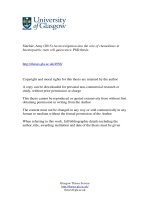
![gherghina et al - 2014 - a study on the relationship between cgr and company value - empirical evidence for s&p [cgs-iss]](https://media.store123doc.com/images/document/2015_01/02/medium_JKXoRwVO1T.jpg)
